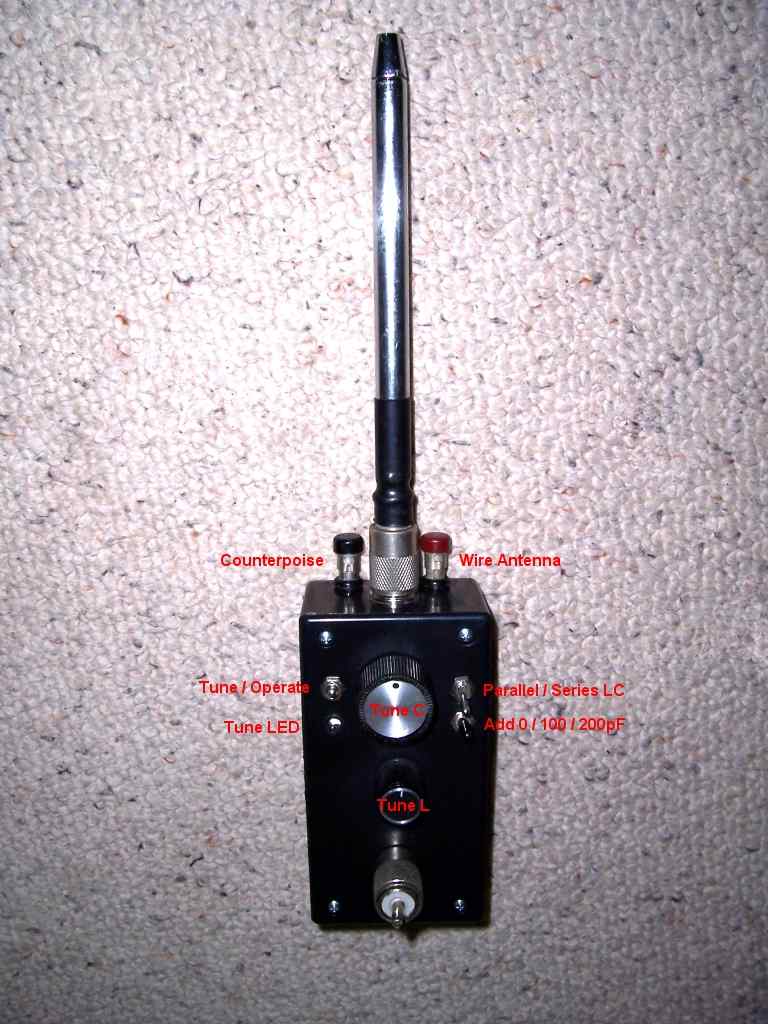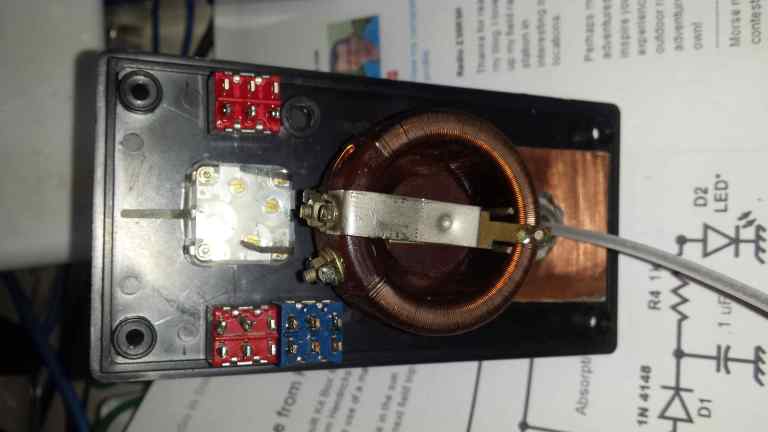
Background
If you're into QRP, you've probably heard of the Miracle Antenna. Otherwise known as the Miracle Whip Antenna, or Miracle Ducker and other such names, the antenna is meant to provide a counterpoise-less portable vertical whip capability to the Yaesu FT817 and similar QRP transceivers. A Google search will produce many hits and the folowing link is a good start: http://www.universal-radio.com/catalog/hamantht/5046.html.
If you're into QRP, you've probably heard of the Miracle Antenna. Otherwise known as the Miracle Whip Antenna, or Miracle Ducker and other such names, the antenna is meant to provide a counterpoise-less portable vertical whip capability to the Yaesu FT817 and similar QRP transceivers. A Google search will produce many hits and the folowing link is a good start: http://www.universal-radio.com/catalog/hamantht/5046.html.
Saturday, 8 March 2014 15:40
Miracle Whip Inspired Antenna Tuner


Search




There are quite a few variants of the design accompanied with many opinions on the effectiveness of the antenna, so after acquiring an FT817ND and looking for a small portable antenna myself, I thought I'd investigate this design to see whether it works for me.
Rather than re-invent the wheel, I reviewed existing sites discovered via a Google search, such as the following:
http://www.ad7c.com/projects/diy-miracle-whip-antenna/
http://www.qsl.net/g4fon/Musings.htm
http://www.g4ilo.com/wonder-wand.html
http://www.qsl.net/kl7r/mw.html
http://home.alphalink.com.au/~parkerp/projects/projped.htm
http://www.dxzone.com/cgi-bin/dir/jump2.cgi?ID=11895
http://myweb.tiscali.co.uk/m1ios/html/wonder%20whip.htm
http://www.qrz.com/db/PD0MNF
along with the Tayloe SWR Indicator for QRP systems.
I also found a tuner design that incorporated a switch to change from a series resonant circuit to a L-Match configuration , which I thought would be useful. The result was an amalgamation of a some good ideas to produce a design which offered quite a few options in small package.
Construction
This version of the tuner is slightly bigger than the Miracle Whip Antenna, but offers a few more functions, such as variable C in series with the variable inductance, the ability to switch to an L-Match L/C configuration and the Tayloe SWR indicator circuit.
Instead of winding my own tapped inductor, I reused a variable inductor recovered from a trashed Codan 6924 transceiver. This inductor has a range of 0 - 140 uH. The variable capacitor is a standard broadcast radio tuning capacitor with two banks of 160pF. I have used only one bank. A centre-off toggle switch allows me to add either 0, 100pf or 200pf to the variable capacitance.
I realise that this particular inductor may be hard to obtain, however I wanted to try this as it's fully variable with quite a large range. Tapped toroidal inductors will obviously also work, however you may find that the tuning may not be as sharp as with an inductor with greater tuning granularity.



How well does it work?
Well, like most other people have said about their 'Miracle Whips', they work... sort of. With the 1.4m long telescopic whip, and using 2.5 Watts from the FT817ND, I have made contacts on 20m, 40m and 80m.
These were when conditions were very good. The best I report I recieved was a 56, but the station I was talking to had an amazingly large and effective antenna, so his end was doing all of the work. Nevertheless, I was heard.
When I removed the whip and replaced it with a 10m piece of hookup wire, even with it laying horizontally at 1m off the ground, along with a 3m counterpoise, I got much, much better results.
Of course I soon confirmed the obvious; the longer the antenna, the better the results.
So it's not really a miracle antenna, but one that radiates enough to be heard by stations with decent receive antennas if the conditions are good. But it is amazing what 2.5 Watts can do into such a small radiating element.
I've yet to put it through its paces fully, however the tuner has so far been able to match any piece of wire I've attached to it on all bands between 160m and 10m and tuning is simple and repeatable. According to the FT817ND's SWR meter, I've been able to get the SWR down to close to 1:1 on all of the frequency and antenna configurations attempted so far, .
I've noticed that on the lower bands, the L-Match position works much better than the series LC configuration. Even though both tune up effectively, the L-Match postion receives better by about 1-2 'S' units and gets better reports on transmit.
The Tayloe SWR indicator circuit works well particularly with the high intesity Red LED that I used. When matched, the LED lights up brightly on TX and shifting tuning off resonance immediately dulls the glow. Because the RX noise is also proportionally lowered when out of tune, I'm not sure that the SWR indicator offers that much benefit operationally.
It's just as easy to tune the antenna by ear simply by peaking the receive noise volume. In every case so far, the peak noise has correlated with a perfectly tuned antenna as confirmed by both the Tayloe SWR indicator and the transceiver's internal VSWR meter. So, much as I like the LED SWR indicator, I haven't yet found any advantage in having it in the unit so far.
Where's the Schematic?
Hopefully I'll update this in the next week or two ...
Well, like most other people have said about their 'Miracle Whips', they work... sort of. With the 1.4m long telescopic whip, and using 2.5 Watts from the FT817ND, I have made contacts on 20m, 40m and 80m.
These were when conditions were very good. The best I report I recieved was a 56, but the station I was talking to had an amazingly large and effective antenna, so his end was doing all of the work. Nevertheless, I was heard.
When I removed the whip and replaced it with a 10m piece of hookup wire, even with it laying horizontally at 1m off the ground, along with a 3m counterpoise, I got much, much better results.
Of course I soon confirmed the obvious; the longer the antenna, the better the results.
So it's not really a miracle antenna, but one that radiates enough to be heard by stations with decent receive antennas if the conditions are good. But it is amazing what 2.5 Watts can do into such a small radiating element.
I've yet to put it through its paces fully, however the tuner has so far been able to match any piece of wire I've attached to it on all bands between 160m and 10m and tuning is simple and repeatable. According to the FT817ND's SWR meter, I've been able to get the SWR down to close to 1:1 on all of the frequency and antenna configurations attempted so far, .
I've noticed that on the lower bands, the L-Match position works much better than the series LC configuration. Even though both tune up effectively, the L-Match postion receives better by about 1-2 'S' units and gets better reports on transmit.
The Tayloe SWR indicator circuit works well particularly with the high intesity Red LED that I used. When matched, the LED lights up brightly on TX and shifting tuning off resonance immediately dulls the glow. Because the RX noise is also proportionally lowered when out of tune, I'm not sure that the SWR indicator offers that much benefit operationally.
It's just as easy to tune the antenna by ear simply by peaking the receive noise volume. In every case so far, the peak noise has correlated with a perfectly tuned antenna as confirmed by both the Tayloe SWR indicator and the transceiver's internal VSWR meter. So, much as I like the LED SWR indicator, I haven't yet found any advantage in having it in the unit so far.
Where's the Schematic?
Hopefully I'll update this in the next week or two ...